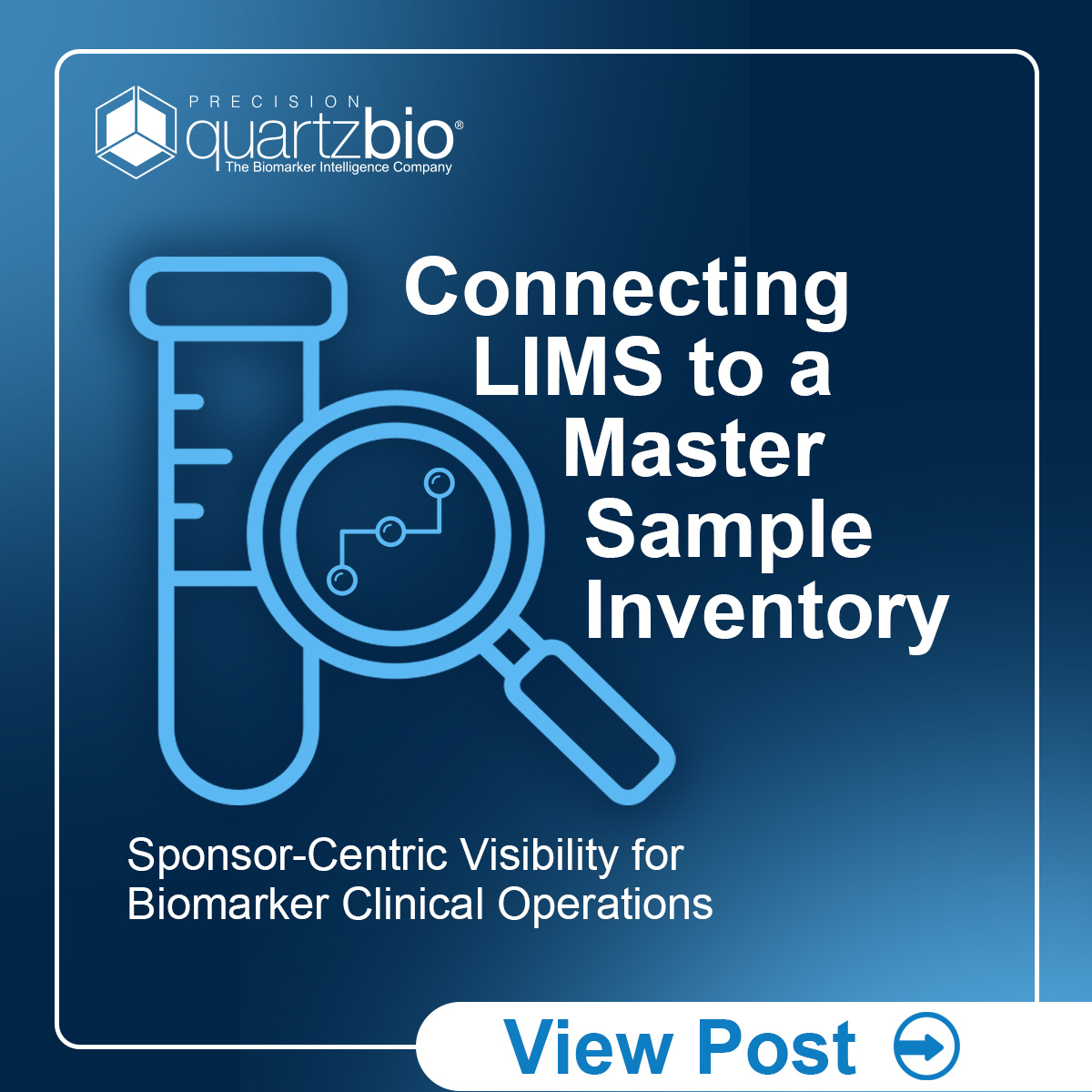
Complex biospecimen operations are inherent in modern clinical trials. For recent protocols, biospecimen collections are designed to be broad and to enable flexible selection from the variety of biomarker assay technologies that are available. Biomarker clinical operations are critical to realizing the potential of biomarker data generation plans.
Multiple Labs, Multiple LIMS; Lack of Sponsor-Centric Visibility
Given the expanding footprint of sites, labs, and biorepositories, there is no sole source where sponsors can find information on biospecimens and get insights into the whereabouts of a given specimen within its complex journey across sites, labs, and biorepositories.
In this post, we explore the relationship between “lab-centric” and “sponsor-centric” sample inventory reporting, and how connecting these inventories can keep data generation on track.
Most clinical trial sample and biomarker data are generated and stored in the laboratory information management systems (LIMS) of individual labs and biorepositories (Figure 1). LIMS-based reporting provides sponsors with “lab-centric” information – for example, status of shipments to and from a given lab and specific assay results. However, these individual LIMS-based reporting systems are siloed, and do not connect to other data sources, such as other LIMS, electronic data capture systems (EDCs), and informed consent forms (ICFs).
LIMS-based Reporting Provides Limited Window of “Lab-Centric” Visibility

Figure 1. LIMS-based reporting is limited to providing a focused window into data from individual screening labs, biorepositories, and specialty labs performing specific biomarker assays.
LIMS-based reporting does not pull in data from other systems or EDC. Depending on LIMS configuration, some, but not all, LIMS provide information on samples received versus samples expected. Similarly, not all LIMS provide sponsors with insight into samples not collected per the protocol, samples collected out of the protocol, and future samples expected according to the protocol. Even when this information is provided, it applies to samples at a single laboratory, and sponsors often use manual processes to achieve visibility across labs.
Further, LIMS-based reporting has no sample reconciliation ability, and, with many LIMS, it is difficult to connect a sample/derivative to the correct version of the consent form.
LIMS-based reporting varies by laboratory and by system; custom, sponsor-centric reporting is likely to require custom programming, hindering the creation of bespoke summaries, key performance indicator reports (KPIs), and trend reports.
Sample Intelligence (SI) Delivers Sponsor-Centric Reporting
In contrast to LIMS, which are limited to providing focused information about samples processed by individual laboratories, QuartzBio’s Sample Intelligence Solution:
- Centralizes & harmonizes data across all sites, labs, storage facilities including 3rd party systems, plus all EDC sample collection data
- Identifies discrepancies across source systems
- Visibility on custom summaries, KPIs, trend reports
- Reports “Expected” vs. “Actual” by mapping subjects to collection groups defined by protocol version or informed consent version
- Provides context of protocol amendments, schedule changes, informed consent
By connecting trial data sources to a technology-enabled Master Sample Inventory, QuartzBio enables operations teams to gain visibility into sample status across sample collection, processing, testing, and storage — including key questions like:
- Are we collecting the samples we expect (and need)?
- What samples were collected? Which of these samples have been processed? Which samples are in storage and can be tested?
- When do we have enough samples to trigger batch processing?
- Are samples consented for collection and assay testing?
- Are samples of sufficient quality for assay testing to generate reliable, high-quality data?
- What data has been generated on these samples? How many pre- / post-treatment data point pairs do we have?
Operations teams evaluating the QuartzBio solution often ask how the information provided by LIMS and other sample inventory systems fits with SI. Because SI is a platform-agnostic, lab-agnostic solution, any individual inventory system and LIMS can feed into SI to give biomarker operations teams the insights they need. Unlike individual LIMS, which are designed to track information on samples within an individual lab (“lab-centric” view), SI brings together information from all systems that are part of the study.
Only SI provides context of protocol amendments, schedule changes, and changes to informed consent tracking, and only SI consistently provides teams with visibility on custom summaries, KPIs, and trend reports.
A master sample inventory is most crucial because it enables discrepancy checks and site performance trend analysis across systems. In addition to these capabilities, QuartzBio SI provides interactive, enhanced visualizations to enable rapid corrective actions.
See Sample Intelligence in action at our webinar, “Overcoming Clinical Sample Chaos,” where Bill Hall presents a use case illustrating how a master sample inventory can streamline biomarker and clinical operations.

